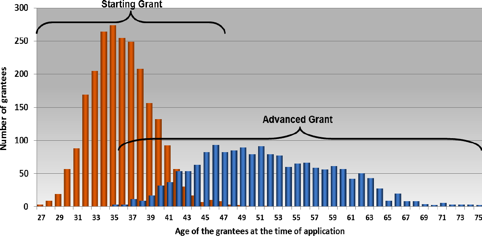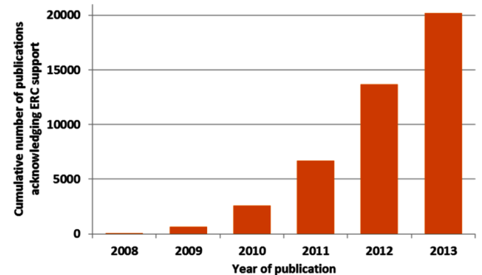The kick-off of Horizon 2020 offers a good opportunity for evaluating the 7th Framework Programme (FP7). We will do this through a report that will be published during the CNR’s workshop held in Rome, on February 11th. This report will be mainly focused on the performance and numbers of Italian contractors that, in the last seven years, manage to get a European grant. Such data will be updated to December 2013, thus close to the end of the Programme.
Those interested to examine in depth these topics are recommended to participate to the workshop (click here to register).
Last data publicly available about the FP7 are those included in a report published by the European Commission in August 2013, which reveals that, between 2007 and 2012, for 379 grants more than 113,000 proposals were submitted, the majority of which – about 103,000 – reached the first evaluation phase. More than 20,000, then, reached the budget-negotiation phase, for a total request of €32.7 billion. Even though the complete data regarding 2013 are not available yet, the massive participation to the just-closed funding programme is quite clear. A participation which is not limited to Europe: 170 countries are involved in the sponsored projects, and the principal ones - besides UE Member and Associated Countries – are US, Russia, China, Brazil and India.
Funds distribution
Considering funds distribution based on types of organization, the rapid growth of secondary education institutions over the considered 6-year period immediately stands out, with more than €3.2 billion as total funding in 2012. Quite different, on the other side, is the trend for public institutions (excluding research and education institutions), the least financed category, with less than €200 million over the same 6-years. Somewhere in between these two extremes, research organizations register a sharp increment between 2007 and 2008, then maintain a low growth rate until 2012, when they reach an overall funding around 1.8 billion euro. Slow, but constant, is also the growth rate of small and medium companies, just higher than €1.2 billion.
Coming back to research institutions, the CNR is among the first ten for number of participants to FP7 projects, holding the third place after the French CNRS and the Fraunhofer-Gesellschaft. In general, France and Germany dominate the scene, conquering three positions each. If we consider the first 50 research institutions, 7 are Italian against 9 French and 6 German. In regards to private company, on the other side, Siemens is first, followed by the Spanish Atos and Telefónica Investigación y Desarrollo, whilst the Italian D’Appolonia S.p.a. and STMicroelectronics S.r.l. place themselves, respectively, at the fifth and tenth positions. It is interesting to notice that, in the general ranking of organizations based on the number of participations, no private company is among the first hundred.
Another relevant ranking lists the European Regions by number of participants and amount of European funding obtained: Rome gains, respectively, the third and fifth place. A good result also for Milan (tenth and eleventh), with Paris firmly at the top of both rankings, boasting almost double the participants (4,381 vs 2,545 of the second one) and funding (about 1,9 billion vs 1,1 of the second one).
Programme implementation
European grants cannot be obtained in few days; besides the necessary time for preparing an effective proposal, months usually pass through from the grant closure to grant acceptance. This period is identified as TTG (Time-To-Grant) and has been quantified for each programme, priority area and year. The average TTG is around 320 days, with a minimum of 13 for ERC grants to a maximum of 1,115 for projects in the Transport Area (Aeronautic included).
Also for this reason, the EU tried to introduce simplifying measures for the adopted procedures, such as the further development of the Participant Portal, which lightened the FP7 administrative load. A survey carried out by the network of National Contact Points (NCPs) revealed that more than 70% of users rated as “good” or “excellent” the access to information about FP7, even though these percentages lowered down for grant negotiation or report and review phases (around 40%). It must be added that, in general, the percentage of unsatisfied users did not exceed 20%.
European Research Council
The ERC marks the new approach to frontier research investments in Europe. The necessity of increasing Europe attractiveness – both for the best worldwide researchers and for industrial investments – and producing new knowledge, fostering economic and social developments, lies at the core of the research programmes developed by the ERC. In the next paragraph we will consider the “backstage” of the grants promoted by the European Research Council.
In 2012 the ERC received 7,045 proposals for Advanced Grants e Starting Grants, 11% more than 2011. Since 2007, Italian participation has been quite substantial both in numbers (second place after UK) and in terms of funding requests (third place). But who are the ERC grants’ winners? Mostly 33-35 years old, whilst for the Advanced Grants the age distribution is much wider.

Figure 1
In regards to Synergy Grants, which support research groups, 710 proposals were submitted, of which 11 were selected for receiving funding in the next 6 years.
This funding system is based on a very complex machine: in 2012, the ERC employed 5,912 experts plus 5,000 external referees divided in three main scientific areas (social and human sciences, biological sciences, physical sciences and engineering). On average, every Starting Grant project was evaluated by two or three revisers, the Advanced Grants by two to eight and the Synergy Grants by six. All the experts were paid within their contracts’ times, 15.4 days in 2012 on average (whilst in 2011 the average was 21 days). All this factors allowed commissioners to respect the 60-day deadline for evaluation. The ERC machine gets better year after year.
In 2012, appeals diminished of 14%, despite a 21% increase in funding requests. Choosing only the very best projects and candidates is rewarding: 76 ERC grants’ winners also won important international awards in 2012. But we need to look at the numbers for grasping the real size of the ERC grants’ success, with 20,000 scientific papers produced up to 2013 thanks to this funding. As shown by Figure 2, this production has been increasing year after year.

Figure 2
In order to improve these results even more for Horizon 2020, the ERC budget for grants will increase from €7,5 billion for 2007-2013 to €13,1 billion for 1014-2020. The budget will be distributed as: 485 million for Starting Grants, 713 for Consolidator Grants, 450 million for Advanced Grant and €15 million for the Proof of Concept. The ERC is also becoming a model for the research politics of single countries. In fact, many nations are conforming to it, as shown by the New National Programme for Research (PNR), launched few days ago from the Italian Ministry Carrozza.
The new PNR will now last 7 years (2014-2020) instead of three, in order to align itself with the European Framework Programme Horizon 2020. Other countries, on the other side, support those researchers who obtained an excellent review but not a grant, since only 12% of the ERC proposals receive funding.
Marie Curie Actions and the Doctoral Programmes
Marie Curie Actions (MCA) provides European grants for researchers with no limit of age, gender or nationality. Besides generous support, MCA offers researchers the opportunity of working abroad or in the private sector, allowing them to integrate and enhance their expertise with other skills or useful disciplines for their career. Within the FP7, MCA have been grouped under the programme “People” with a €4 billion budget, equal to 9% of the whole FP7 budget. In 2012, about 11,000 new grants have been assigned. Up to date, MCA have supported researchers of 130 different nationalities, working in 75 countries. According to data relative to December 2012, 36,5% of them are women. MCA particularly focus on PhDs. In fact in 2012, two new initiatives were launched: European Industrial Doctorates (EID) and Innovative Doctoral Programmes. These programmes aim at improving young doctorates’ education by involving them in the private sector, also putting them in contact with eventual future employers.
The Researchers’ Night
The FP7 programme “People” also provides funding for getting citizens closer to science. The researchers’ night is a European event that gathers wide public and researchers every last Friday of the month of September. Launched in 2005, this event has already involved 2,5 million people. In 2012, the Researcher’s Night took place in 350 cities with €4 million allocated for event- production.
FP7 Projects’ publications
More than 16,000 papers have been published in regards to the concluded 3,200 projects. About 47% appeared on high Impact Journals, of which 10% on the top journals for each scientific area.
Conclusions
The overview offered by the European Commission’s report about the several branches of FP7 is of great benefit, both in terms of transparency and to monitor the situation. Thanks to this kind of analysis is indeed possible to identify merits and flaws of a funding programme with such a capacity, evaluate changes to be made, locate sectors that need an intervention and give value to the choices that proved to be convenient. The management of such a funding programme is inevitably complex and only through a constant monitoring it is possible to increase its efficiency. The European Union must learn from previous experience in order to improve, through Horizon 2020, the efficiency of its scientific and technologic research.

